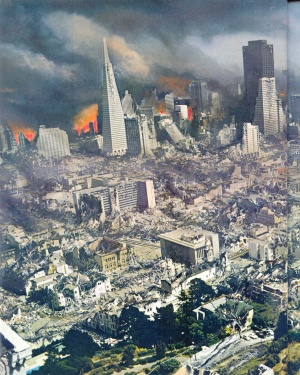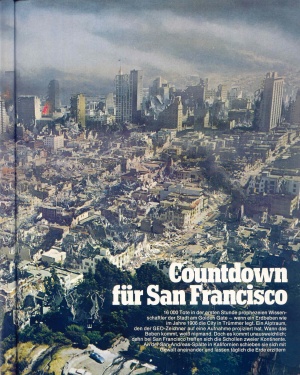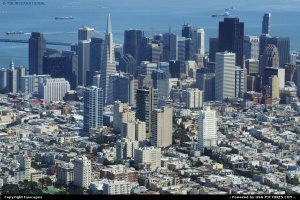Difference between revisions of "Contact Report 104"
(→Source) |
|||
| Line 275: | Line 275: | ||
* http://theyflyblog.com/page/3 | * http://theyflyblog.com/page/3 | ||
==Further Reading== | ==Further Reading== | ||
| − | * Contact reports | + | * Contact reports [[Contact Report 392|392]], [[Contact Report 437|437]], [[Contact Report 516|516]] and [[Contact Report 517|517]] |
Revision as of 19:59, 27 January 2014
This is an unofficial and unauthorised translation of a FIGU publication.
Before reading onward, please read this necessary prerequisite to understanding this document.
Introduction
- Contact Reports volume: 3 (Plejadisch-plejarische Kontakberichte, Gespräche, Block 3)
- Page number(s): 131-133
- Date/time of contact: Wednesday, March 1, 1978
- Translator(s): Larry Driscoll
- Date of original translation: December 14, 2013
- Corrections and improvements made: N/A
- Contact person: Quetzal
Synopsis
Billy travels forward in time with Quetzal and observes as well as photographs the earthquake destruction of San Francisco.
This is the an except of the contact report. It is an unauthorised and unofficial translation and may contain errors.
Contact Report 104 Translation
Billy:
... But tell me Quetzal, can you also penetrate with this old box into other dimensions?
Quetzal:
82. Your question is not logical; what do you want to ask?
Billy:
I have to wonder, whether you can also perform travels with Menara's ship into the past and into the future?
Quetzal:
83. It is possible, but why do you ask?
84. Whenever you ask such questions, then a certain purpose is behind them.
85. Do you want to ask me, whether I am to undertake a travel with you into the future or into the past?
Billy:
Exactly, my son.
Quetzal:
86. Sooo – … for that you reason you have taken with you this large apparatus for photographing?
Billy:
Exactly, my son, but this is not such a complicated thing, as you assume, but quite simply a damn normal camera.
Quetzal:
87. That’s the same thing.
88. However — where then do you want to go?
Billy:
To Frisco, my son, to San Francisco, but into the future. Namely to that time when the city is destroyed by the earthquake. I would be interested in how everything looks, when the first severe quake is over, and exactly this I want then also to photograph. This will surely be possible to do, won’t it? And surely it doesn’t matter, if I then also publish these photographs, if they come out well, is that okay?
Quetzal:
89. Surely there would be nothing to object against this, for thereby very many people would then leave San Francisco and settle elsewhere before the catastrophe arises.
90. This would save very many human lives.
91. Certainly, I do agree with this, but it requires several hours if I should take you there.
92. This old ship in fact, and presently I have no other ship at my disposal, needs a longer time for preparation, if accordingly you are to be back here again in normal time at first dawn of the morning.
Billy:
This is not too difficult, because you can bring me back here again to roughly the same time, as when you had taken me out from the bed.
Quetzal:
93. This would be possible.
Billy:
Good, in fact, then I would still be able to sleep a little. So let us go.
Quetzal:
94. As you wish, but in the meantime we cannot have any conversation.
Billy:
It makes no difference to me, let’s just go; I am strained like a string before breaking.
Quetzal:
95. So be it then.
96. You truthfully are tireless.
...
Quetzal:
97. Here we are about 300 kilometers away from San Francisco.
98. Down there, you see the fissures of the earth as they already exist from long ago.
99. What you do see are the extentions of Andreas Fault which have risen up to the surface of the Earth.
Billy:
Can I photograph them?
Quetzal:
100. There is nothing to object against this, but, you could also capture this scene on your film in the present time, the year 1978, because the changes are only extremely small, and not likely recognizable in the photographs.
Billy:
Nevertheless, I would like to photograph them.
Quetzal:
101. Then do it.
102. Come here, look – here this floor hatch, so as you see, after shifting the plate aside, there is freed this very fine pointed sight-plate, through which you can look outside.
103. Through this you can photograph.
Billy:
That's all right, Quetzal, but do you know that when I take photographs from inside of the ship, they are always afterwards very fuzzy and blurred. Is there then no other way, you know, that I can perhaps, walk outside?
Quetzal:
104. You have your best overall view from above, here from out of the ship.
105. On the other hand, this time you will get sharp and clear images on your film, because the propulsion of this ship will not harm your film by radiations.
106. You only have to then pay attention that you do not photograph directly down through the area of the propulsion, because the very strong irradiation of light could harm your film.
107. The smallest damage of the film could be that the finished images would appear to be lightened by a light source.
108. In the worst case an overexposure would happen.
Billy:
Is this the light, which reaches there so far downward and looks like a search light?
Quetzal:
109. That’s correct. So then take care, that these masses of light do not reach into the area of your photograph limits
Billy:
I will try it.
...
Quetzal:
110. Are you at the end of your work?
Billy:
I am, my son. Perhaps I still have not been careful enough regarding the light. Somehow it appeared to me, as though I would always have seen a shimmering of light in the lens.
Quetzal:
111. So try it once more.
Billy:
No, let us go to Frisco first, because I have only one film with me, and besides it is only a standard negative-film.
Quetzal:
112. As you wish.
113. Walk away from the hatch.
114. So, – good, it...
Billy:
Man, this is indeed crazy, just look, all is smoking there in front.
Quetzal:
115. There lies San Francisco.
116. So then, we are here, now take your photographs.
Billy:
Man alive, Quetzal, this looks much worse, than I have imagined. Yet listen now: somewhere must be a building, which should be known as the America-Building or similar; so get me there. This I want to photograph above all, so that no one can come and claim that I would have taken photographs of the last great quake at the turn of the century.
Quetzal:
117. Now, we are here, my friend, but this time pay more attention to the light beam.
Billy:
I will try for that.
...
Billy:
Thanks Quetzal, this suffices, rush still back a little ... Good, okay — moment. ...Good, now fly still a bit to the right side there — Good, okay, thanks. Man alive, this is gigantic, the horrifying destruction. ... Thanks, Quetzal, I have again several photographs. This should likely be enough. So please do fly back again towards the strange bulges of the Andreas Fault.
Quetzal:
118. As you wish, but bear in mind, that we are already slowly exceeding our time and I have to make preparations for the flight back.
Billy:
All right, Quetzal, you can start with them at once, when we are at the place. I want to see everything one more. But how so quickly a half hour passes in the future.
Quetzal:
119. The time is the same; it only seems very much shorter to you because of your attention to the events which you have seen.
Billy:
Of course, this I know. Ah, indeed, we already are here. Now just do your work.
...
Quetzal:
120. Well, my friend, here we are again.
121. We are here by around 30 minutes earlier, than when you had left your warm bed.
The San Francisco Earthquake Photos by Wendelle C. Stevens
The mysterious "time" photos of the future destruction of San Francisco in a great earthquake have always been highly controversial. We, that is, Lee Elders, myself and Brit Nielsen, were at the farm in Schmidruti one evening in 1978 when Mr. Meier mentioned time travel and a “trip” he had taken with the Pleiadians to view the great San Francisco earthquake predicted for the future, which he said he had been allowed to photograph with his own camera. We of course insisted on seeing the photographs, and continued to do so until Meier left the room and came back with one of those photo shop return envelopes in his hand. It contained the pictures still in it, together with the negatives. He had taken these pictures on negative film in contrast to his earlier photographing of the spacecraft on ASA 100 positive slide transparency film.
He opened the envelope and spread out eleven colour prints on the kitchen table there. He said that they were pictures of the future San Francisco quake. Then he passed them around the table one by one to all of us to examine. There were at least nine to ten people sitting around that table at that time, which included his wife Kalliope, Engelbert and his wife Maria, Jacobus, Bernadette, and a couple more whose names I don’t remember.
I carefully studied each picture as they came to me, trying to recognize familiar landmarks and buildings, and any prominent new structures I had never seen before. I looked carefully at cars shown in the streets below for style and any configurations not familiar at the time. I did see smaller cars with smoothly rounded corners and no external projections, and some of these had half-glass and others full-glass cabin tops, making them look more like bugs than boxy cars.
I saw the World Trade Center Building cracked through its steep pyramidal shape from upper right to lower left, from the viewer’s angle, and another big rectangular building with higher rectangular towers on either end, collapsing in the middle and taking the two towers down with it. There was shooting flame, black and light smoke, and water and gas spewing from broken pipes, and there was a lot of dust roiling out from the collapsing rectangular building.
We passed the pictures around a second time and we all studied them again, and then Mr. Meier collected them up, put them back in the envelope, and took the envelope back out of the kitchen once more. We were all in shock at what we had just seen, and discussed it only briefly before that meeting broke up an all went to bed for the night.
A few days after that, Meier was summoned to a new contact and was asked to bring the photographs with him which he did. The visitors wanted to have their scientists look at the pictures, too, and they took the negatives and prints with them. When Meier tried to get the pictures back, he was rebuked for showing them to us without their approval, and against their instructions not to do so until after the event. Those pictures have never been returned to him. Thus today we do not have any solid evidence that those pictures were ever taken.
A year later, on another trip to Switzerland, our attention was called to an article in a copy of the European edition of GEO Magazine, which carried a painting of the future destruction of San Francisco that was remarkably similar to one of Meier’s photographs, the one showing the steep pyramidal World Trade Center building coming down. I was amazed at the close similarity to the one I had seen in Meier’s house the year before, but could not re-visualize the detail seen well enough to make a valid comparison. I later obtained copies of the GEO magazine and then remembered that the article there only one painting of the destruction bled over two pages whereas I had seen eleven pictures in Meier’s house. Now, where did he get the other ten if, as his accusers say, “He copied the pictures from the GEO magazine article”.
When Meier asked the Pleiadians about this, they said that any artists or real sensitives seeking such information could tap into the same reality and get the same pictures, because they do now exist in our future time.
I don’t think a great many people actually saw those dozen photographs in Meier’s house, which looked very real to me, like real photographs, not photographs of paintings, and maybe no more than the few around the kitchen table that night. All others would very likely come to the conclusion that those pictures were one and the same. But there are at least ten people who do know otherwise and I am one of these.
Mr. Meier sincerely believes that he took a trip in time during this contact, but this was not the first, and so he was not entirely unfamiliar with the phenomenon of time travel.
There are two schools of thought concerning this exotic condition. One is that time is a structured, inflexible, linear phenomenon that can not be altered or changed. Those will choose to believe that if this is not an outright falsification, then it is at best a manipulated condition like the virtual realities we are just beginning to experiment with, or that it is a very real projection from stored memory using quite sophisticated 3-D viewing systems.
The other concept is that time indeed is a flexible, non-linear phenomenon that is navigable like space, and that once we know what time is and how to use it, we can really go backward and forward in time and perceive events there.
In another discussion of time and space, Mr. Meier was told that just like there are milestones in space, there are confluences in time; and just like we can get to a given destination in space by many routes, we can get to a given point in time by different confluences.
It was suggested that space and time are opposite aspects of the same phenomenon, like matter and energy, and that once we understand the phenomenon we can navigate time as we now do with space. When we learn its nature we will be able to convert space to time and time to space as we choose. In fact it was suggested that an understanding of this phenomenon will be necessary before we can really undertake interstellar travel. We live between the extremes of time and space, and we can not travel in one without influencing the other. When we move in space it takes time, and any movement in time shifts space.
A new book, "ASTRO-METRICS of Undiscovered Planets and Intelligent Life Forms" by Dr. Yuri Danjo and Col. Ron Blackburn (USA Ret.) attempts to apply new formulas to understand these relationships and other exotic phenomena such as size and other apparently limiting conditions. You will need to be a very good mathematician to understand these concepts.


